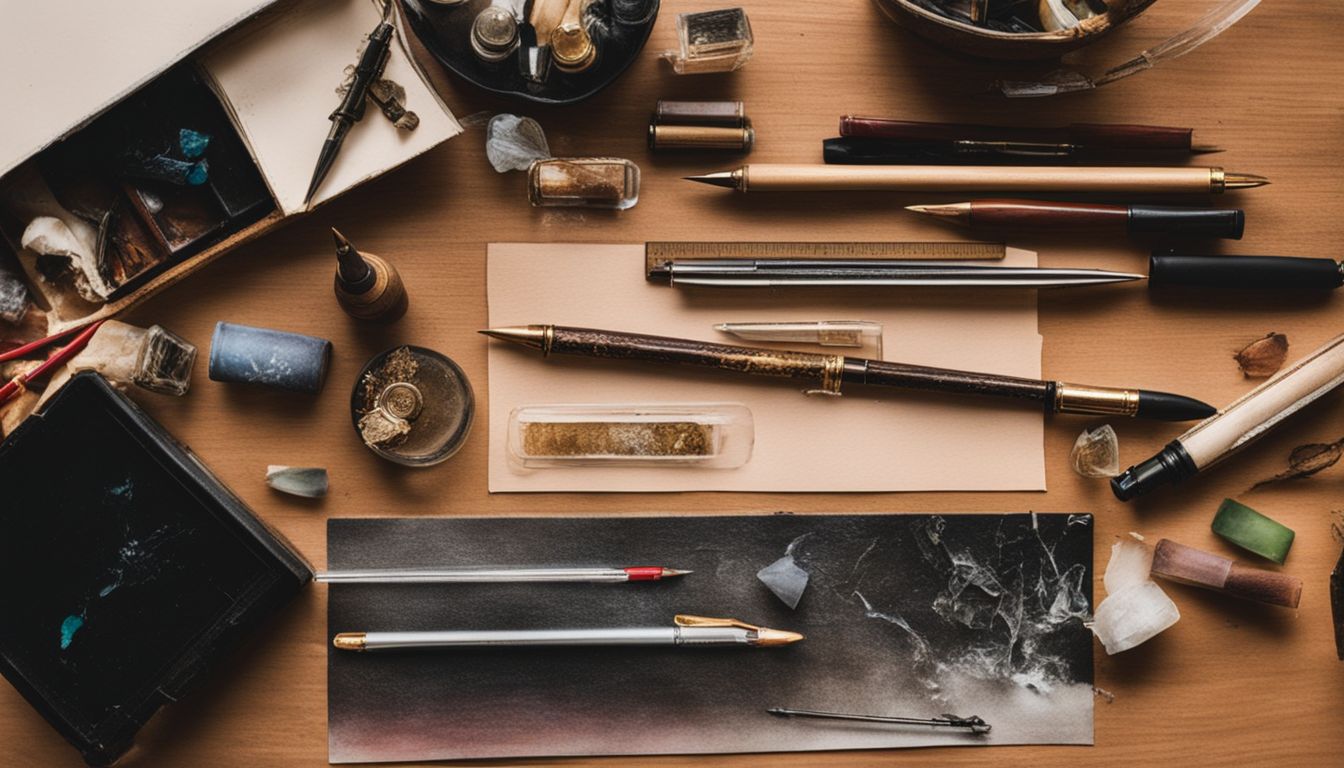Many people struggle with creating smooth and precise calligraphy lines. This skill is key for beautiful handwriting. Our guide offers techniques and tips to master your script, focusing on the tools and practices that make perfecting calligraphy lines easier.
Get ready to transform your writing!
Essential Tools for Calligraphy

Calligraphy requires specific tools for achieving precise lines. These include fountain pens, pointed nibs, a rolling ruler, and more.
The Pencil
In calligraphy, a pencil becomes your best friend for drawing guidelines before the final inking. You should choose one that marks lightly to make sure these lines can be erased after your ink dries.
This step is key for keeping your work neat and professional-looking. Make sure not to press too hard with the pencil to avoid making grooves in the paper which could mess up your final strokes.
With this simple tool, you sketch out horizontal guidelines ensuring every letter sits perfectly on or between these lines. For designs that require straight edges or precise measurements, like creating practice sheets for minuscules and majuscules or drafting outlines before committing to ink, the pencil proves indispensable.
Its role in preparing stock images and png files for digital works also cannot be overlooked. By having a trusty pencil at hand, you lay the foundation for excellence in every piece of calligraphy work you create.
The Rolling Ruler
The rolling ruler emerges as an important tool for calligraphers seeking to achieve flawless guidelines. This inventive tool, unlike a traditional ruler, facilitates the quick drawing of parallel lines across the page, eliminating the need for manual measurement each time.
This effectiveness becomes critical when preparing calligraphy practice sheets or designing the layout for textura and other scripts. Its wheel mechanism sails smoothly over paper, ensuring straight lines spaced consistently, which reduces the possible margin of error in line placement due to pencil thickness and human carelessness.
A plethora of users share their personal encounters with how the rolling ruler has revolutionized their practice sessions by simplifying ruling up techniques. It’s exceptionally useful for novices who might find it difficult to maintain their lines straight with just a T-square ruler.
This tool simplifies adhering to advice such as “the first line ruled should be perpendicular to the left edge of the page,” ensuring precision from the beginning to the end of project preparations.
Let’s move onto Fountain Pens and Pointed Nibs, tools that infuse grace and accuracy to every stroke.
Fountain Pens and Pointed Nibs
Fountain pens with pointed nibs are key tools for crafting elegant calligraphy lines. They allow artists to control the thickness of their strokes by applying varied pressure. As you press harder, the nib spreads apart, creating bolder lines.
Lighter touches result in fine and delicate marks. This mechanism is essential for achieving the contrasting line weights that bring letters to life.
Using these pens requires practice and a steady hand. A good grip helps maintain control over your pen, leading to more consistent strokes. Drawing calligraphy guidelines before starting ensures your writing stays aligned and proportionate.
Pointed nibs work well on smooth paper that allows for fluid motion without catching or tearing fibers, making each stroke crisp and clear. Whether working on all lowercase or mixing minuscule and majuscule letters, these tools support precision and style in your script work.
Understanding Calligraphy Guidelines
Understanding calligraphy guidelines plays a crucial role in achieving well-crafted scripts. It involves grasping the fundamental principles of horizontal and vertical guidelines as well as comprehending the anatomy of calligraphy lines.
What are Calligraphy Guidelines?
Calligraphy guidelines are essential for maintaining uniformity and precision in calligraphy scripts. The horizontal guidelines dictate the height of the letters, ensuring consistent lettering size.
Meanwhile, vertical guidelines help in controlling the slant angle while writing, resulting in cohesive and aesthetically pleasing script alignment.
These fundamental principles lay the groundwork for creating visually stunning calligraphy pieces by providing a structured framework for precise letter formation. By employing these guidelines, calligraphers can achieve consistency and elegance in their work, elevating the overall quality of their scripts.
Horizontal Guidelines
Horizontal guidelines play a vital role in regulating the height of letters in calligraphy. They provide a foundational structure for consistent and uniform script. When ruling these lines, it’s crucial to include space for ascenders and descenders, ensuring that each letter is appropriately proportioned within the designated boundaries.
By adhering to these guidelines, calligraphers can achieve balanced and harmonious compositions that enhance the visual appeal of their script.
The careful attention to detail needed when creating horizontal guidelines supports the overall aesthetic quality of calligraphy work. Observing this precise approach ensures that each letter maintains its proper proportions, contributing to the overall coherence and elegance of the script.
Whether using traditional scripts or modern brush calligraphy styles, mastering the art of ruling clear and accurate horizontal guidelines is fundamental for achieving professional-looking results.
Vertical Guidelines
Vertical guidelines are crucial to maintain consistent slant angles in calligraphy. They offer a reference point for the angle at which the letters are formed, ensuring uniformity and precision in the script.
When creating vertical guidelines, remember to start with a line perpendicular to the left edge of the page. This initial line serves as an anchor, guiding subsequent lines for maintaining a uniform slant throughout the writing process.
Utilizing tools like fountain pens and pointed nibs in conjunction with vertical guidelines improves control and accuracy when executing various calligraphy scripts. The use of vertical guidelines is vital to achieve professional-looking calligraphy.
Properly ruled vertical lines contribute to balanced letterforms and harmonious composition across different styles of calligraphy, such as brush or modern scripts.
The Anatomy of Calligraphy Lines
The anatomy of calligraphy lines encompasses crucial elements that contribute to the overall structure and aesthetics of the script. Comprehending these components is vital for attaining accuracy and uniformity in calligraphy.
The primary components comprise the baseline, x-height, ascender line, descender line, and slant angle. The baseline acts as a reference point for positioning the letters, while the x-height dictates the lowercase letters’ height.
Ascender and descender lines direct the height of ascending and descending strokes correspondingly. Ensuring a consistent slant angle across all characters guarantees uniformity in the script.
Grasping these foundational components is indispensable for crafting visually appealing calligraphy scripts with balanced proportions and uniform letterforms.
Creating Calligraphy Guidelines
To create calligraphy guidelines, follow a step-by-step process and consider traditional and modern/brush calligraphy scripts. Embrace advanced techniques like using a laser liner, an Ames Lettering Guide, or crafting your own guide sheet template.
Step-by-Step Process
Creating calligraphy guidelines involves a step-by-step process that ensures precision and consistency in your script. Here’s how to create calligraphy guidelines effectively:
- Choose the right paper: Opt for smooth, high-quality paper that minimizes ink spreading and unwanted marks.
- Determine the spacing: Measure and mark consistent intervals between each line to maintain uniformity throughout your writing.
- Draw light lines: Using a pencil or rolling ruler, lightly sketch the guidelines to avoid leaving heavy marks on the final piece.
- Use a laser liner: For precise vertical lines, employ a laser liner to align and guide your hand movements accurately.
- Consider an Ames Lettering Guide: This tool provides adjustable slotted templates for creating parallel lines at various angles.
- Customize guide sheet templates: Tailor guide sheets to accommodate specific scripts, adjusting line heights and angles accordingly.
- Maintain consistency: Regular practice with customized guide sheets enhances overall precision and fluency in calligraphy.
Traditional Calligraphy Scripts
Traditional calligraphy scripts, such as Spencerian script, are noted for their elegant angular cursive style. These scripts have been used for large commissions, where the letter height is typically 4mm and written at a slant of approximately 52°.
Examples of traditional calligraphy scripts include Textura and other historical styles that uphold the essence of classic calligraphy.
In addition to the stock photos you can find online, experiencing firsthand how these traditional calligraphy scripts are crafted can enhance your understanding of this art form even further.
Modern/Brush Calligraphy Guidelines
When it comes to modern or brush calligraphy, guidelines are essential for maintaining consistent height and spacing. These guidelines help direct the strokes and maintain uniformity in the script.
For modern calligraphy, crafting your own guide sheets can be advantageous as they can be customized to fit different writing styles.
Using a laser liner or Ames Lettering Guide can assist in creating precise guidelines for brush calligraphy. Moreover, employing digital tools such as calligraphy guideline generators or vector software can streamline the process of producing custom guidelines for various script practices.
Overall, utilizing these techniques ensures that your modern and brush calligraphy maintains high standards of consistency and precision.
Advanced Techniques for Perfect Lines
Perfecting calligraphy lines requires mastering advanced techniques. Laser liners, Ames lettering guides, and custom guide sheet templates are instrumental in achieving precise calligraphy lines.
Using a Laser Liner
A laser liner is a valuable tool for maintaining consistent calligraphy lines. It helps create straight, evenly spaced guidelines, enabling beginners to master the art and ensuring precise strokes for enhanced aesthetic quality.
Laser liners also assist in controlling pressure for line variations and practicing minuscules and majuscules. By incorporating a laser liner into your calligraphy practice, you can reveal the secrets of perfecting your script with ease.
Moving on to the “Ames Lettering Guide”…
Ames Lettering Guide
The Ames Lettering Guide, a drafting tool with a rotating disc, improves ruling lines’ speed and accuracy. It contains four rows of holes and a scale from 2 to 10, measuring 1/32 of an inch for setting desired line heights.
This allows users to create parallel guidelines quickly and precisely, saving time and effort.
With the Ames Lettering Guide’s precise measurements and ease of use, calligraphers can ensure consistent letter height across their work. The guide is a valuable tool for both beginners and experienced calligraphers seeking efficiency in ruling lines for various scripts.
Creating Your Own Guide Sheet Template
Creating your own guide sheet template is a crucial step in perfecting calligraphy lines. Begin by selecting an appropriate paper size and type for your practice sheets. Afterward, utilize a ruler to sketch evenly spaced horizontal and vertical guidelines on the paper.
Ensure there is ample separation between each line to avoid overlap, and delicately inscribe the lines to enable easy erasure when necessary. Opt for traditional or modern calligraphy scripts as a point of reference for crafting your personalized guide sheet template.
To further customize this process for improving your skills, contemplate employing advanced tools such as laser liners or Ames lettering guides designed to streamline the creation of precise guidelines.
Practical Tips for Drawing Straight Lines
Mastering the skill of drawing straight lines in calligraphy can be challenging but highly rewarding. A few techniques, like mastering a T-Square ruler and ruling up effectively, can make all the difference.
Ruling Up Techniques
When ruling up for calligraphy, ensure to leave space between each line to prevent overlapping. Write lines lightly for easy erasure.
- Use a light pencil to create the marginal guidelines on both sides of your paper.
- Start with the horizontal lines and then proceed with the vertical lines using a ruler for precision.
- Ensure that the spacing between each line is consistent and appropriate for the script you are practicing.
- Consider using an adjustable rolling ruler for accuracy in creating guidelines on different paper sizes or shapes.
- Double-check your guidelines before starting your calligraphy work, ensuring they are straight and evenly spaced.
Tips for Using a T-Square Ruler
When using a T-square ruler, ensure the first line is perpendicular to the left edge of the page. Due to human error and pencil thickness, there may be variations in line heights.
Using a T-square ruler: First lines should be drawn accurately ensuring they are perpendicular to the left edge of the page. This precision ensures consistency throughout your work.
Variations in line height can occur due to human error and differences in pencil thickness.
Utilizing Digital Tools
Enhance your calligraphy practice by leveraging digital tools, such as a Calligraphy Guideline Generator and Vector Software for Calligraphy Lines. Discover how these tools can streamline and improve your artistic creations.
Calligraphy Guideline Generator
The calligraphy guideline generator is a helpful digital tool that aids in creating personalized guidelines for calligraphy practice. It streamlines the process by enabling users to input specific parameters such as line spacing, angle, and style to produce customized guidelines for various script practices.
This tool is advantageous for both beginners and experienced calligraphers seeking uniformity and accuracy in their work. By using the calligraphy guideline generator, individuals can effectively generate guide sheets tailored to their chosen writing instruments, including fountain pens and pointed nibs.
Moreover, this digital resource provides flexibility by accommodating traditional calligraphy scripts as well as modern or brush calligraphy styles. Calligraphers can improve their skills through careful practice on personalized guide sheets crafted with the aid of this innovative tool.
Vector Software for Calligraphy Lines
Vector software for calligraphy lines provides an efficient way to create and manipulate digital designs, offering a range of tools that enable users to produce intricate calligraphy lines with ease.
This type of software allows artists to design decorative line dividers and borders set in various styles, such as PSD decorative line divider designs, while providing the flexibility to customize these elements based on individual preferences.
Moreover, individuals can access free vector calligraphy lines border sets through this software, empowering them to incorporate visually appealing and professional-looking calligraphy into their projects.
Moreover, vector software is intended to enhance the creation process by offering multiple variations of free PSD decorative line divider designs. In the world of calligraphy guidelines generation and manipulation, utilizing vector software presents a solution tailored specifically for artists looking for advanced digital editing capabilities—it unveils the secrets necessary for personalized creations within the constantly evolving realm of art and design.
Maintaining Consistency in Practice
Maintaining consistency in practice is essential for improving calligraphy skills. It helps in refining your letterforms and ensuring uniformity across different scripts, making it a crucial aspect of honing your craft.
If you want to uncover more insightful tips on perfecting your script, continue reading the article.
Practice Sheets for Minuscules and Majuscules
Practice sheets for lowercase and uppercase calligraphy provide a structured framework for practicing the foundational elements of calligraphy. The following list provides techniques and tips for using practice sheets effectively:
- Consistent Letter Formation: Practice sheets allow for uniform formation of both lowercase and uppercase letters.
- Size and Spacing: Guidelines on practice sheets ensure consistency in letter size and spacing, aiding in creating visually pleasing script.
- Stroke Direction: The sheets guide the direction of each stroke, helping develop muscle memory for fluid writing.
- Pressure Control: Utilize the guidelines to refine control over pen pressure, essential for achieving elegant calligraphy lines.
- Diagonal Elements: Practice sheets include diagonal elements to exercise precision in executing slanted strokes, crucial in various calligraphy scripts.
- Building Confidence: Regular use of practice sheets contributes to developing confidence in handling different styles and complexities within calligraphy.
- Debugging Mistakes: The structured format allows identifying and correcting errors systematically, promoting continuous improvement.
- Tracking Progress: Use practice sheets to track progress by comparing earlier attempts with the latest ones, acknowledging advancements in skill development.
Textura and Other Script Practices
To excel in the Textura script, use practice sheets dedicated to this specific calligraphy style. These sheets are crafted to refine and customize your skills for achieving a precise hand in Textura.
Regular practice aids in mastering various calligraphy scripts, including Textura, as well as other intricate styles like Gothic and Italic.
Now, let’s explore practical advice for advancing your skill set with advanced techniques for perfecting lines.
Conclusion
Mastering calligraphy lines involves grasping and employing various tools, guidelines, and techniques. Whether it’s traditional scripts or modern brush calligraphy, creating flawless lines is an art that can be honed through practice and regularity.
Enhanced methods such as laser liners or digital tools can elevate your precision. By upholding exactness in your script, you can reveal the secrets to excelling in the detailed realm of calligraphy lines.
For more inspiring ideas and to further refine your calligraphy skills, explore our collection at Faith Calligraphy.
FAQs
1. What is the art of calligraphy lines?
The art of calligraphy lines refers to the technique and skill involved in creating beautiful handwriting or lettering with a brush or pen.
2. How can I perfect my script in calligraphy?
Perfecting your script in calligraphy involves practice, mastering different techniques, and learning helpful tips that enhance your writing style.
3. Are there specific techniques for mastering the art of calligraphy lines?
Yes, there are several techniques for mastering the art of calligraphy lines like controlling pen pressure, understanding stroke sequence, and maintaining consistent spacing between letters.
4. Can anyone learn to master the art of calligraphy lines?
Absolutely! With dedication and regular practice using various tips and techniques, anyone can learn to master the beautiful craft of creating perfect scripts withunique styles.




Leave a Reply
You must be logged in to post a comment.